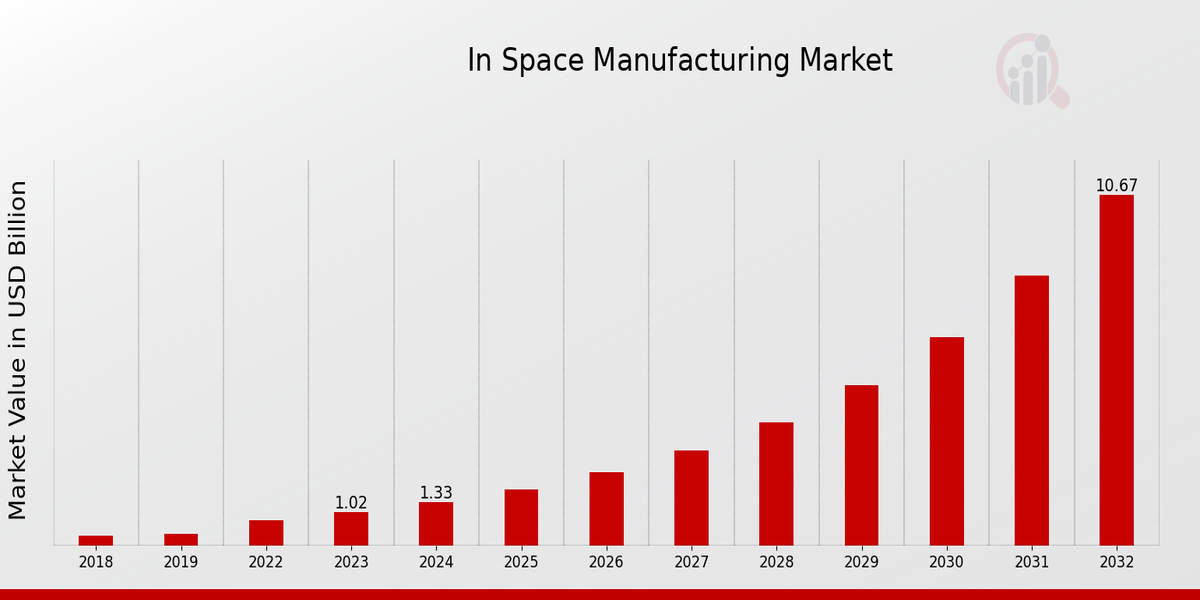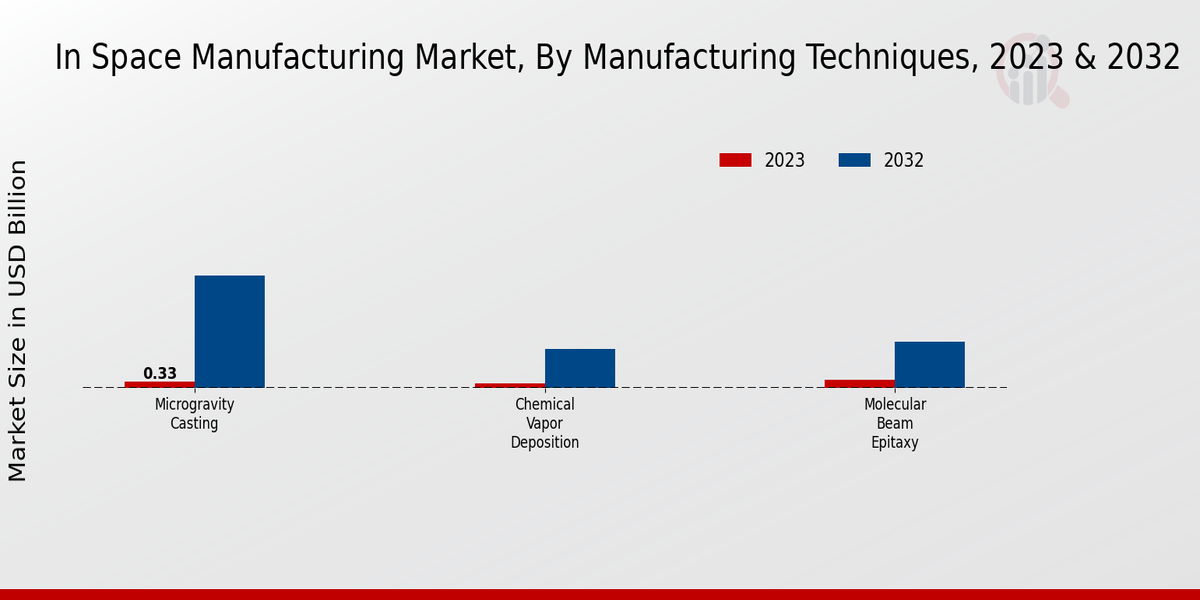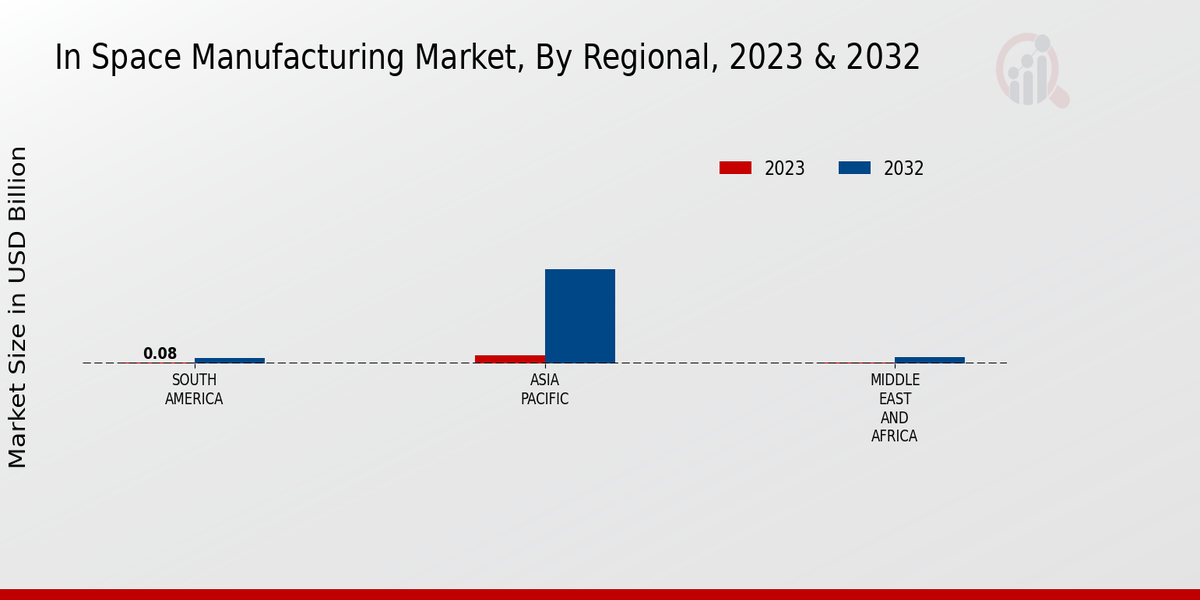In Space Manufacturing Market Overview
In Space Manufacturing Market Size was estimated at 1.02 (USD Billion) in 2023. The In Space Manufacturing Market Industry is expected to grow from 1.33 (USD Billion) in 2024 to 10.669 (USD Billion) by 2032. The In Space Manufacturing Market CAGR (growth rate) is expected to be around 29.78% during the forecast period (2024 - 2032).

Source Primary Research, Secondary Research, MRFR Database and Analyst Review
Key In Space Manufacturing Market Trends Highlighted
Most Important Market Trends
In Space Manufacturing (ISM) is gaining momentum as a transformative industry with significant potential for disruption. Key market drivers include advancements in 3D printing, robotics, and materials science, enabling the production of complex structures and materials in space. Opportunities lie in the development of lunar and Martian habitats, satellite constellations, and space-based infrastructure.
Recent trends indicate a shift toward decentralized manufacturing in space, reducing reliance on Earth-based supply chains. Artificial intelligence (AI) and machine learning (ML) are playing a crucial role in optimizing production processes and improving efficiency. Partnerships between government agencies, private companies, and academia are fostering innovation and collaboration.
Governments worldwide are investing heavily in space exploration and utilizing ISM for scientific research and technology demonstrations. The increasing demand for space-based services, such as satellite communications and remote sensing, is driving the need for reliable and sustainable manufacturing capabilities in space. As the industry matures, ISM is expected to revolutionize the way humans explore, utilize, and live beyond Earth.
In Space Manufacturing Market Drivers
Increasing Demand for Space Exploration and Satellite Deployment
The growing demand for space exploration and satellite deployment is a major driver of the In Space Manufacturing Market Industry. Governments and private companies are investing heavily in space exploration missions, satellite deployment, and the development of space-based infrastructure. This has created a need for advanced manufacturing technologies that can produce components and structures in space, reducing the cost and complexity of space missions.In-space manufacturing enables the production of custom parts, repair of satellites, and construction of large structures in orbit, which is expected to drive the growth of the market.
Advancements in Additive Manufacturing Technologies
Advancements in additive manufacturing technologies, such as 3D printing, are driving the growth of the In Space Manufacturing Market Industry. These technologies allow for the production of complex and customized parts in space, reducing the need for traditional manufacturing processes. Additive manufacturing enables the production of parts with intricate geometries and lightweight materials, which are essential for space applications. The ability to manufacture parts in space also eliminates the need for transportation and storage, reducing costs and lead times.
Government Initiatives and Partnerships
Government initiatives and partnerships are playing a significant role in the growth of the In Space Manufacturing Market Industry. Governments worldwide are recognizing the potential of in-space manufacturing and are investing in research and development programs. Partnerships between government agencies and private companies are also driving innovation and collaboration in the industry. These initiatives are expected to accelerate the development and adoption of in-space manufacturing technologies, leading to increased market growth.
In Space Manufacturing Market Segment Insights
In Space Manufacturing Market Manufacturing Techniques Insights
The In Space Manufacturing Market segmentation by Manufacturing Techniques includes 3D Printing, Microgravity Casting, Chemical Vapor Deposition, and Molecular Beam Epitaxy. Among these, 3D Printing is anticipated to gain significant traction in the coming years owing to its ability to produce complex parts with reduced lead times and costs. The In Space Manufacturing Market revenue for 3D Printing is projected to reach USD 1.5 billion by 2024, growing at a CAGR of 25.6%. Microgravity Casting, on the other hand, is expected to witness a moderate growth rate due to its limitations in producing high-quality parts.Chemical Vapor Deposition and Molecular Beam Epitaxy are niche techniques that are primarily used to produce specialized materials and electronic devices. The In Space Manufacturing Market segmentation provides valuable insights into the key trends, growth drivers, and challenges affecting the market. by understanding the dynamics of each segment, manufacturers can make informed decisions and tailor their strategies to capitalize on the growth opportunities.
Source Primary Research, Secondary Research, MRFR Database and Analyst Review
In Space Manufacturing Market Materials Insights
The Materials segment is a crucial aspect of the In Space Manufacturing Market, encompassing various materials utilized in the fabrication of structures, components, and equipment in space. Key materials in this segment include Metals, Polymers, Ceramics, and Composites. Metals, such as aluminum and titanium alloys, are widely employed due to their strength and lightweight properties. Polymers, including polyetheretherketone (PEEK) and polyetherimide (PEI), offer advantages such as flexibility, durability, and resistance to radiation. Ceramics, such as silicon carbide and zirconia, are known for their high-temperature resistance and strength.Composites, combining different materials like carbon fiber and epoxy resin, provide a unique blend of strength, lightweight, and thermal stability. The In Space Manufacturing Market for Materials is projected to reach $X billion by 2024, exhibiting a significant growth rate driven by the increasing demand for materials with specialized properties in space applications.
In Space Manufacturing Market Product Application Insights
The Product Application segment of the In Space Manufacturing Market is expected to witness significant growth in the coming years, driven by the increasing demand for advanced and innovative products in various industries. Communication Satellites is projected to hold a dominant share of the market in 2023, owing to the growing need for satellite-based communication networks for data transmission, navigation, and remote sensing. Medical Implants is another promising segment, with increasing demand for 3D printed implants and tissue engineering products for personalized healthcare solutions.Scientific Equipment is also expected to contribute significantly to the market growth, driven by the need for lightweight and durable equipment for space exploration and research. Automotive Components is another emerging segment, with the potential for manufacturing lightweight and high-performance components for electric vehicles and autonomous vehicles. Overall, the Product Application segment of the In Space Manufacturing Market is poised for substantial growth, driven by technological advancements and increasing demand for innovative products across various industries.
In Space Manufacturing Market End Use Insights
The In Space Manufacturing Market is segmented into government, commercial, and research institutes based on end use. The commercial segment is estimated to account for the largest share of the market in 2023, owing to the increasing demand for space-based products and services. The government segment is expected to grow at a significant rate during the forecast period, due to the increasing investments in space exploration and defense programs. The research institutes segment is also expected to witness steady growth, driven by the increasing focus on research and development in the space sector.
In Space Manufacturing Market Regional Insights
The In Space Manufacturing Market is segmented into North America, Europe, APAC, South America, and MEA. North America is expected to hold the largest market share in 2023, owing to the presence of major space agencies such as NASA and SpaceX. Europe is expected to be the second-largest market, followed by APAC. The APAC region is expected to witness the highest growth rate during the forecast period, due to the increasing investment in space exploration and manufacturing by countries such as China and India. South America and MEA are expected to have a relatively smaller market share, but are expected to grow at a steady pace.The In Space Manufacturing Market is expected to grow significantly in the coming years, driven by the increasing demand for space-based manufacturing and the development of new technologies.

Source Primary Research, Secondary Research, MRFR Database and Analyst Review
In Space Manufacturing Market Key Players and Competitive Insights
There are several major players in the In Space Manufacturing Market which are constantly investing in research and development activities in order to gain a competitive advantage in the market with innovative and advanced solutions. Leading players in the In Space Manufacturing Market are also concentrating on entering into strategic collaboration and partnership with other companies in order to enhance their product portfolio and market position. In Space Manufacturing Market has been experiencing rapid growth on account of the increasing demand for space exploration and an efficient and cost-effective manufacturing technology in space. In Space Manufacturing Market is however, fragmented in nature with presence of several large and small size players. Established players in In Space Manufacturing Market have a strong market presence and extensive product or service portfolios, wherein, start up players in the market are concentrating on developing innovative, best in class and disruptive technology.A leading player in the In Space Manufacturing Market is Made In Space, which is a company pioneering in technology and product development for 3D printing in space. The company has developed and installed several 3D printers in the International Space Station ISS, which has been used to manufacture a wide array of components and tools . Made In Space is also conducting research and development activities to develop new materials and 3D printing processes that can be best suited for manufacturing in space. Similarly, another major player in In Space Manufacturing Market is Tethers Unlimited, which is engaged in developing and deploying electrodynamic tethers for use in space. From a commercial perspective, electrodynamic tethers are long conductive cables which can be used to generate electricity, propel spacecraft and remove debris from orbit. Tethers Unlimited have installed several electrodynamic tethers in the ISS and are conducting research to find new applications of the technology. Another competitor in the market is Space Systems/Loral, a leading provider of spacecraft and satellite systems. SSL has developed a number of spacecraft for commercial and government customers. It manufactures medium-sized and heavyweight communication satellites, Earth observation satellites and planetary exploration spacecraft. Space Systems/Loral is also developing innovative products in space manufacturing such as 3D printing or additive manufacturing. Overall, the competitive environment In Space Manufacturing Market is dynamic with presence of a number of established and emerging players developing and launching new products and services in the market, in order to cater to the growing needs of the space industry.
Key Companies in the In Space Manufacturing Market Include
- Nanoracks
- Thales Alenia Space
- Lockheed Martin Corporation
- Northrop Grumman
- Maxar Technologies
- Rocket Lab
- Tethers Unlimited, Inc.
- Sierra Space
- Airbus
- Made In Space, Inc.
- Axiom Space
- Boeing
- Blue Origin
- Momentus Space
- Redwire Space
In Space Manufacturing Market Industry Developments
Recent advancements in space exploration and technology are driving the growth of the In-Space Manufacturing Market, which is projected to reach a valuation of USD 10.669 Billion by 2032, exhibiting a CAGR of 29.78% from 2024 to 2032. Several notable developments have shaped the market landscape in recent years. In 2023, NASA announced plans to establish a commercial low Earth orbit (LEO) destination platform, fostering collaboration between government and private entities in space manufacturing. Furthermore, companies like Made In Space, Inc. and Redwire Space have made significant strides in developing and deploying 3D printing technologies for in-space manufacturing of spacecraft components, demonstrating the potential for cost-effective and efficient production in space. These advancements are expected to continue driving market growth in the coming years.
In Space Manufacturing Market Segmentation Insights
In Space Manufacturing Market Manufacturing Techniques Outlook
- 3D Printing
- Microgravity Casting
- Chemical Vapor Deposition
- Molecular Beam Epitaxy
In Space Manufacturing Market Materials Outlook
- Metals
- Polymers
- Ceramics
- Composites
In Space Manufacturing Market Product Application Outlook
- Communication Satellites
- Medical Implants
- Scientific Equipment
- Automotive Components
In Space Manufacturing Market End Use Outlook
- Government
- Commercial
- Research Institutes
In Space Manufacturing Market Regional Outlook
- North America
- Europe
- South America
- Asia Pacific
- Middle East and Africa
| Report Attribute/Metric |
Details |
| Market Size 2023 |
1.02 (USD Billion) |
| Market Size 2024 |
1.33 (USD Billion) |
| Market Size 2032 |
10.669(USD Billion) |
| Compound Annual Growth Rate (CAGR) |
29.78% (2024 - 2032) |
| Report Coverage |
Revenue Forecast, Competitive Landscape, Growth Factors, and Trends |
| Base Year |
2023 |
| Market Forecast Period |
2024 - 2032 |
| Historical Data |
2019 - 2023 |
| Market Forecast Units |
USD Billion |
| Key Companies Profiled |
Nanoracks, Thales Alenia Space, Lockheed Martin Corporation, Northrop Grumman, Maxar Technologies, Rocket Lab, Tethers Unlimited, Inc., Sierra Space, Airbus, Made In Space, Inc., Axiom Space, Boeing, Blue Origin, Momentus Space, Redwire Space |
| Segments Covered |
Manufacturing Techniques, Materials, Product Application, End Use, Regional |
| Key Market Opportunities |
Lightweight satellite manufacturing Specialized materials production Remote infrastructure construction Biopharmaceutical research On demand manufacturing |
| Key Market Dynamics |
Rising demand technology advancements government support increasing launch capabilities private sector investment |
| Countries Covered |
North America, Europe, APAC, South America, MEA |
Frequently Asked Questions (FAQ) :
The In-Space Manufacturing Market is expected to reach a value of 10.669 USD Billion by 2032.
The market is anticipated to grow at a CAGR of 29.78% from 2024 to 2032.
North America is expected to lead with a market size of 4.67 USD Billion by 2032.
The 3D Printing segment is projected to reach a value of 3.25 USD Billion by 2032.
Key players include Nanoracks, Thales Alenia Space, Lockheed Martin Corporation, Northrop Grumman, and Maxar Technologies.
The Microgravity Casting segment is expected to grow to a size of 2.75 USD Billion by 2032.
The Chemical Vapor Deposition segment is anticipated to reach 2.2 USD Billion by 2032.
Asia Pacific is expected to grow to a market size of 1.5 USD Billion by 2032.
The Molecular Beam Epitaxy segment is projected to achieve a market size of 2.42 USD Billion by 2032.
The overall market size in 2023 is valued at 1.02 USD Billion.

















